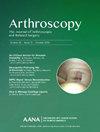对无法修复的肩袖撕裂进行上囊重建术,可为糖尿病患者和非糖尿病患者带来良好的临床疗效。
IF 4.4
1区 医学
Q1 ORTHOPEDICS
Arthroscopy-The Journal of Arthroscopic and Related Surgery
Pub Date : 2024-09-24
DOI:10.1016/j.arthro.2024.09.024
引用次数: 0
摘要
目的:比较糖尿病(DM)患者和非糖尿病(DM)患者在上关节囊重建术(SCR)治疗不可修复的肩袖撕裂(RCT)后的临床疗效:方法:将2012年至2020年期间因不可修复的肩袖撕裂使用筋膜自体移植进行SCR手术且随访至少2年的患者分为非糖尿病组和糖尿病组。采用倾向评分匹配法选择与患者特征相匹配的对照组。只有患者的 HbA1c 结果:我们研究了 154 例接受 SCR 的患者(非 DM,130 例;DM,24 例)。经过匹配后,每组选出 21 名患者。所有临床结果在 2 年后均有明显改善(所有 PC 均有改善):使用筋膜自体移植物对不可修复的RCT进行SCR治疗,对有DM和无DM的患者都能产生良好的临床疗效,包括ROM。两组患者的术后效果无明显差异:回顾性队列研究,III级。本文章由计算机程序翻译,如有差异,请以英文原文为准。
Superior Capsule Reconstruction for Irreparable Rotator Cuff Tears Yields Good Clinical Outcomes for Patients With and Without Diabetes Mellitus
Purpose
To compare the clinical outcomes after superior capsule reconstruction (SCR) for irreparable rotator cuff tears (RCTs) in patients with and without diabetes mellitus (DM).
Methods
Patients who underwent SCR using fascia lata autograft for irreparable RCTs between 2012 and 2020 with a minimum 2-year follow-up were divided into non-DM and DM groups. Propensity score matching was used to select controls matched for patients’ characteristics. Only patients with glycosylated hemoglobin <8% were eligible. The visual analog scale for shoulder pain, American Shoulder and Elbow Surgeons and Japanese Orthopaedic Association scores, and acromiohumeral distance were evaluated preoperatively and at 2 years postoperatively. Shoulder active range of motion (ROM) was evaluated preoperatively and at 6 months, 1 year, and 2 years postoperatively. Graft integrity and postoperative complications that required additional surgery were evaluated. The Wilcoxon signed-rank test and Mann-Whitney U test were used to compare continuous variables. Pearson χ2 test and Fisher exact test were used for categorical variables. The interaction between the postoperative period and ROM was analyzed by the Friedman test and Wilcoxon rank-sum test with the Holm-Sidak post hoc test.
Results
We studied 154 patients (non-DM, 130; DM, 24) who underwent SCR. After matching, 21 patients were selected in each group. All clinical outcomes significantly improved at 2 years (all P < .05) in both groups. We found no significant differences in clinical outcomes and rates of patients who achieved minimal clinically important differences in visual analog scale and American Shoulder and Elbow Surgeons scores between the groups (P = .10 to ≥.999). The rates of graft tear (both 9.5%) and complications (non-DM, 4.8%; DM, 0%) were not significantly different (both P ≥ .999).
Conclusions
SCR using fascia lata autograft for irreparable RCTs yields good clinical outcomes, including ROM, in patients with and without DM. No significant differences in postoperative outcomes were observed between the 2 groups.
Level of Evidence
Level III, retrospective cohort study.
求助全文
通过发布文献求助,成功后即可免费获取论文全文。
去求助
来源期刊
CiteScore
9.30
自引率
17.00%
发文量
555
审稿时长
58 days
期刊介绍:
Nowhere is minimally invasive surgery explained better than in Arthroscopy, the leading peer-reviewed journal in the field. Every issue enables you to put into perspective the usefulness of the various emerging arthroscopic techniques. The advantages and disadvantages of these methods -- along with their applications in various situations -- are discussed in relation to their efficiency, efficacy and cost benefit. As a special incentive, paid subscribers also receive access to the journal expanded website.

 求助内容:
求助内容: 应助结果提醒方式:
应助结果提醒方式:


